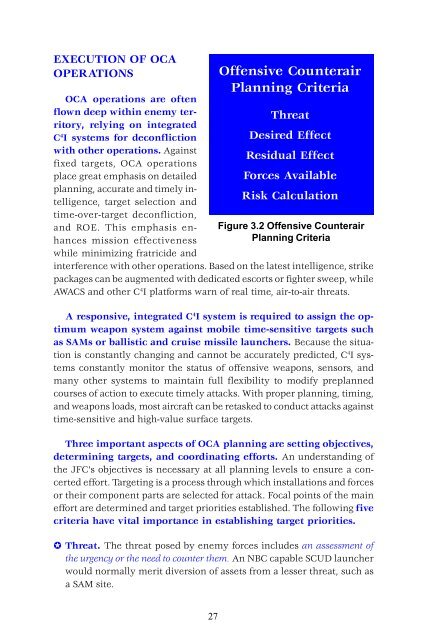Air Force Doctrine Document 2-1.1
Air Force Doctrine Document 2-1.1
Air Force Doctrine Document 2-1.1
You also want an ePaper? Increase the reach of your titles
YUMPU automatically turns print PDFs into web optimized ePapers that Google loves.
EXECUTION OF OCA<br />
OPERATIONS<br />
OCA operations are often<br />
flown deep within enemy territory,<br />
relying on integrated<br />
C 4 I systems for deconfliction<br />
with other operations. Against<br />
fixed targets, OCA operations<br />
place great emphasis on detailed<br />
planning, accurate and timely intelligence,<br />
target selection and<br />
time-over-target deconfliction,<br />
and ROE. This emphasis enhances<br />
mission effectiveness<br />
while minimizing fratricide and<br />
interference with other operations. Based on the latest intelligence, strike<br />
packages can be augmented with dedicated escorts or fighter sweep, while<br />
AWACS and other C 4 I platforms warn of real time, air-to-air threats.<br />
A responsive, integrated C 4 I system is required to assign the optimum<br />
weapon system against mobile time-sensitive targets such<br />
as SAMs or ballistic and cruise missile launchers. Because the situation<br />
is constantly changing and cannot be accurately predicted, C 4 I systems<br />
constantly monitor the status of offensive weapons, sensors, and<br />
many other systems to maintain full flexibility to modify preplanned<br />
courses of action to execute timely attacks. With proper planning, timing,<br />
and weapons loads, most aircraft can be retasked to conduct attacks against<br />
time-sensitive and high-value surface targets.<br />
Three important aspects of OCA planning are setting objectives,<br />
determining targets, and coordinating efforts. An understanding of<br />
the JFC’s objectives is necessary at all planning levels to ensure a concerted<br />
effort. Targeting is a process through which installations and forces<br />
or their component parts are selected for attack. Focal points of the main<br />
effort are determined and target priorities established. The following five<br />
criteria have vital importance in establishing target priorities.<br />
❇ Threat. The threat posed by enemy forces includes an assessment of<br />
the urgency or the need to counter them. An NBC capable SCUD launcher<br />
would normally merit diversion of assets from a lesser threat, such as<br />
a SAM site.<br />
27<br />
Offensive Counterair<br />
Planning Criteria<br />
Threat<br />
Desired Effect<br />
Residual Effect<br />
<strong>Force</strong>s Available<br />
Risk Calculation<br />
Figure 3.2 Offensive Counterair<br />
Planning Criteria
















